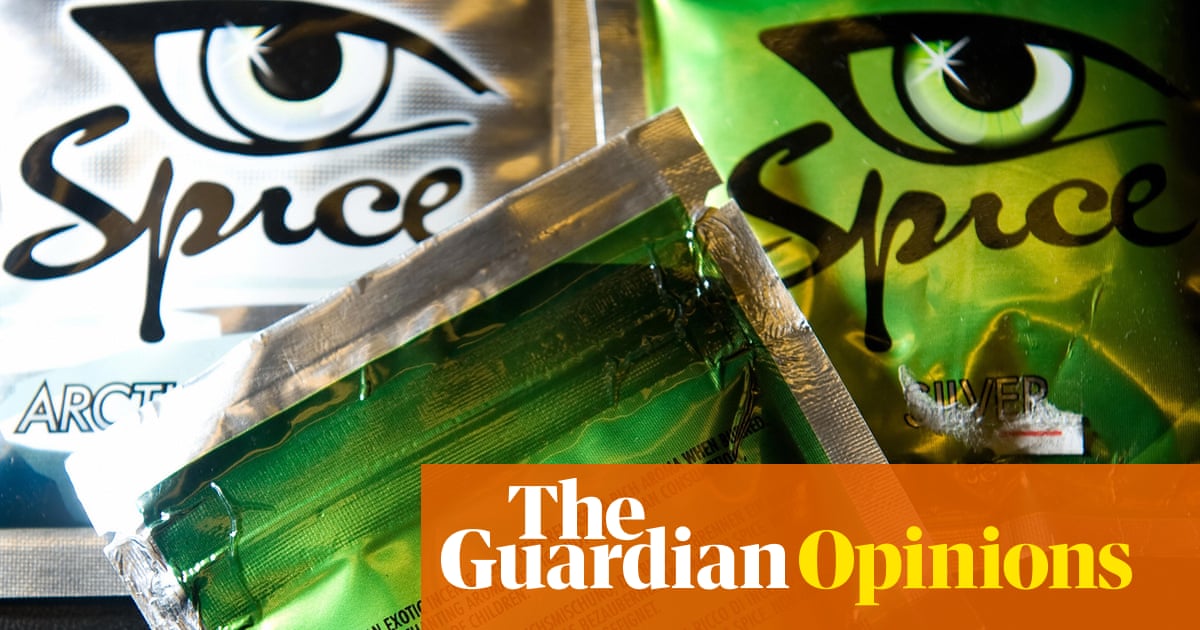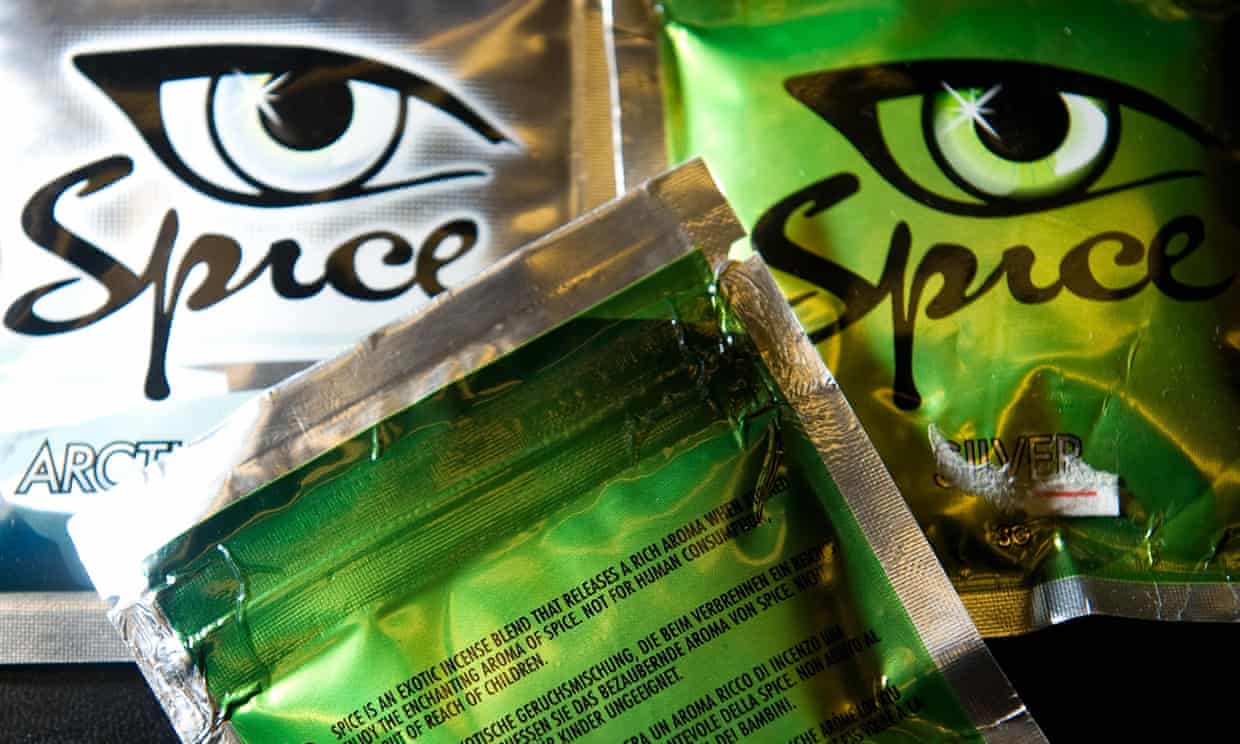Spice is more than a deadly drug – it’s a window on our society


You can tell a lot about a society by the drugs it depends on. In the UK right now, the main drug of choice is booze. Despite 338,000 hospital admissions in 2017-18 and at least 6,000 deaths (not to mention 900 fatalities at the hands of drunk drivers), alcohol brings in £12bn in tax revenue, which makes it far easier to swallow.
Cocaine is another recession-proof perennial. London alone snorts a reported 23kg a day, with more than 600 deaths last year, as purity soars and the price falls due to rising Colombian output. Yet cocaine still has the brand identity of a luxury good, conferring on its users the association of being in an elite class of substance abuser.
Cannabis, after decades of demonisation as “killer skunk”, has been rebranded to the public as an essential medicine, now that hedge funds are pouring millions into new legal cannabis markets in Canada and the US.
Finally, for those who own only the shoes in which they stand, there’s spice: the so-called zombie drug ripping a path through the lives of Britain’s poorest communities, and selling a lot of newspapers along the way.
It was spice – or more specifically, a variant of it called MDMB-CHMICA – that killed Catherine Kenny, a homeless 32-year-old woman, in Belfast in 2016.
Indeed, spice users are often homeless, either living in hostels or on the streets. In Manchester, an estimated 95% of all homeless people use it. Spice came to prominence in the late 2000s and early 2010s in British prisons, where it could be easily smuggled in, either soaked on to letters or passed over by visitors. It was also ideal for dodging compulsory drug testing in prison: most tests can’t detect it, and it lacks the familiar fug of cannabis, so it can be smoked surreptitiously.
More than that, however, spice kills time like no other drug. A year smoking spice, some users say, passes as quickly as a few months. Unlike weed, spice doesn’t make you giggle or lead you towards elaborate, sidelong conclusions; unlike cocaine, it doesn’t increase your confidence. In most cases, it just knocks you out cold. And that’s the point: users want total shutdown. Oblivion is preferable to the life that the poorest in our society are forced to live.

Users often smoke spice specifically to lose consciousness, in freezing car parks and under dripping railway bridges. A few tokes and it’s game over for six hours. But as users get habituated, they twitch and awaken, sweating through their sleeping bags. The only remedy: another joint of spice.
Some of them say spice has replaced a bundle of other addictions: instead of booze, heroin, crack and downers, spice is all they now use. It’s less work to score and brings the same net benefits.
It’s also cheap. Spice is actually a generic name that refers to a whole class of medicines called synthetic cannabinoid receptor agonists, which control functions as fundamental as sleep, appetite and libido. These drugs were developed in medical research labs, but the formulae were hijacked from research literature and sold as “legal highs” in the first internet drug craze of the late 2000s. Every time the UK tried to crack down on it, a new variant – usually more potent, often more toxic, and always more obscure – has been developed to take its place. There are now dozens if not hundreds of synthetic cannabinoid mutations now available.
The UK finally banned it and all variants in 2016, but that only made its sale more profitable, and supply has stayed level. Spice is now sold on the streets for £5 for a 0.5g bag. A few quid is all you need to make a whole day vanish.
To tabloid news editors and cruel voyeurs, spice users have become known as zombies. The message is clear: as undead subhumans, they deserve and need no sympathy, no help, no understanding. They are to be mocked, feared and further marginalised.
But they are also in grave danger. Synthetic cannabinoids, when abused, can cause tachycardia, hypertension, hallucinations, nausea and vomiting, seizures, memory changes, somnolence, respiratory depression, acute anxiety, psychosis and death. The potency of these chemicals outstrips that of most recreational drugs, often by a factor of 100: an active dose of street heroin might be 100-200mg and a typical line of cocaine might contain 75-100mg, but most variants of spice are active at just 1mg, making accurate dosing impossible.
That’s even before you factor in the steps taken to produce the drug illicitly. Spice is made in China and imported to the UK by criminal gangs, who dissolve the powder in acetone and spray it on to herbal matter such as damiana. The volatile solvent evaporates, leaving the plant matter infused and ready to smoke. The chaos seen in city centres in recent years, with smokers sprawled out on benches or paralysed on pavements, was caused because batches of the drug vary wildly in strength and content: one might contain a 1:100 mix, while another could be as high as 1:10 – meaning a single draw on a joint might incapacitate users instantly.
Solutions to the spice phenomenon exist, but they require dedication, money, and innovative thinking. Instead, councils have responded to central government cuts by slashing drug treatment services by 27% since 2015-16, with the most swingeing cuts – more than 50% – in the areas with the highest rates of drug-related deaths. The only innovation in recent years was a suggestion by police and the Home Office to reclassify spice from class C to class A, thereby further criminalising an already marginalised and vulnerable group: fining and jailing spice-drunk beggars, like a Hogarth print for the 21st century.
An essential first step to addressing the problem would be extensive investment in supported housing, and the reinstatement of cancelled drug treatment services. While heroin and benzodiazepenes, also often taken by street homeless users, have a formalised detox pathway, spice and other drug users should be offered residential rehab, with counselling and support to help them understand and break their cycles of use.
The use of spice is not due to some some individualised moral failing on the part of the users. If it were, its use would be seen at every stratum of society. It is, rather, a natural and inevitable – indeed rational – response to a systemic failure in social care and drugs laws, with poverty at the ultimate root. Spice is the attempted solution to a problem most of us will never consider: how can I get through yet another day with nothing to do and no hope of change? How do I navigate a world in which my highest aspiration is to be invisible, so that I’m not a nuisance to be moved on, or pissed on? In the end, what spice tells us about our society is simple: when you cut holes in a net, don’t be surprised when things fall through.
Mike Power is a freelance journalist specialising in drugs, science and technology and the author of Drugs 2.0
Follow Guardian Cities on Twitter, Facebook and Instagram to join the discussion, catch up on our best stories or sign up for our weekly newsletter
 Pathways Drug Rehabilitation Luxury Addiction Treatment & Detox Center
Pathways Drug Rehabilitation Luxury Addiction Treatment & Detox Center


